Electric Cars in Oregon: Difference between revisions
No edit summary |
No edit summary |
||
| Line 1: | Line 1: | ||
{{GreenIndustry}} | |||
<< '''Back to: [[Green industry]]''' << | << '''Back to: [[Green industry]]''' << | ||
Revision as of 07:19, 14 April 2011

<< Back to: Green industry <<
President Obama wants to cut U.S. oil imports by a third over 10 years, as high gasoline prices threaten economic recovery. The U.S. has lurched from different transportation energy policies[1] in the past several years, favoring fuel cells and then biofuels and now electrification and hydrogen. How far electrification will go is still unclear. Electric vehicles will reduce green house gases and dependence on foreign oil say advocates.
Oregon is coordinating many activities to facilitate successful, widespread deployment of plug-in vehicles[2], reports the Department of Energy. In 2004, Oregon's strategy for greenhouse gas reduction report[3] showed that motor vehicles accounted for more than one-third of Oregon's GHG emissions.
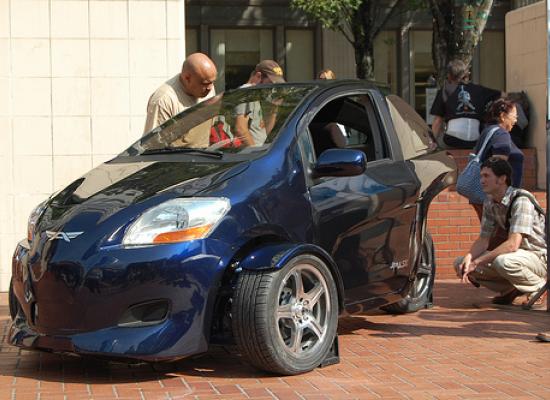
Portland Mayor Sam Adams has pledged to implement a "comprehensive Green Fleet vehicle plan" that includes having 20% of the City's 2,800 vehicles run on electricity by 2030.
There are 40 companies building either electric vehicles or component parts[4], says Drive Oregon[5]. Oregon-made electric vehicles[6] include Arcimoto[7] Brammo[8], Ryno Motors[9], Green Lite Motors[10], MotoCzysz[11] as well as EV Charging Station manufacturers Shorepower[12] and Optimization Technologies[13]. Charging overnight, at non-peak times, helps balance demands on the grid and grid energy storage[14] may help demand spikes.

The Nissan Leaf[15], an all electric car[16], is being tested in Portland, as are Chevrolet Volt[17] and Ford's Focus Electric[18]. Plug-in hybrids[19] have much smaller batteries, running perhaps 10-40 miles on electricity before using a gas engine.
Chevrolet's Volt[20] (right) is a plug-in hybrid, since it is not 100% battery powered. It goes about 40 miles on batteries. The best selling Toyota Prius[21] uses a conventional gas engine but runs on a small battery for the first 4-6 miles. The plug-in hybrid Prius[22] has a bigger battery with a 12 mile range. Batteries can be recharged by plugging them in. That's cheaper than using the car's gas-powered generator to charge them up. Zip Car in Oregon is now offering two plug-in Prius cars for $7/hr.
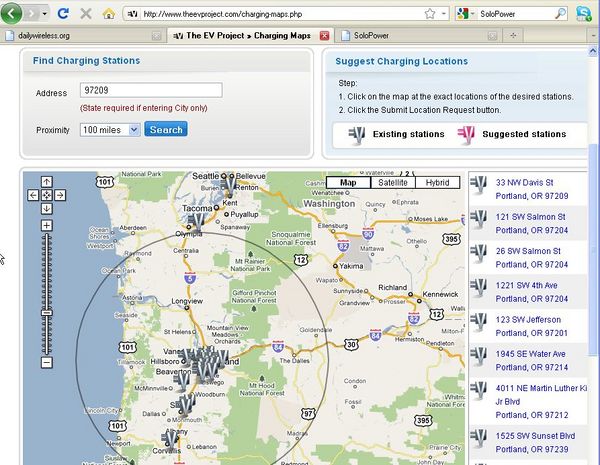
Both the ground breaking Nissan Leaf[23] and the eStar will be limited to a 100 mile range on their Lithium Ion batteries[24]. The Leaf runs only on batteries. When it's out of juice, it's dead. The Nissan Leaf costs $33,000 (before rebates), and has been described as a $16,500 subcompact car that costs double that thanks to a battery estimated to cost $16,500. The Navistar eStar[25], an electric truck, will sell for $150,000 and totes a battery estimated to cost nearly $75,000.
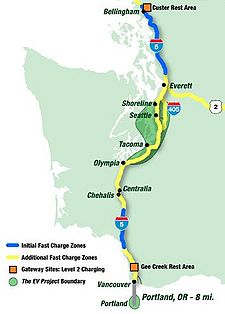
Oregon's Electric Vehicle Charging Network[26] is extending electric car charging stations along the I-5 corridor. It costs only $2-$3 to charge up an all electric car. Electric vehicles keep oil money in the country and may develop a new industry based on innovation - or so the thinking goes.
ECOtality's Fast chargers[27] are available in Portland and Eugene, south to the California border creating a system of electric vehicle (EV) charging stations along the entire length of Interstate 5 in Oregon.
Washington State's Electric Highway project[28] (right), aims to provide enough charge stations to enable longer range traveling. Today's electric cars, typically run out of juice around 100 miles after topped off.
EV4Oregon.com[29] combines Solarworld panels, with Enphase microinverters, battery storage and 220 volt utility feeds to create Electric Vehicle carports that offers Level 1 (30 minute charging) without the expense of a 440 volt line drop[30]. The system claims a 20-minute electric vehicle charging capability by combining battery and 220 volt line power.
The City of Hillsboro is the first in the State of Oregon to install Coulomb Technologies[31] Level II ChargePoint Networked Charging Stations[32] for plug-in and electric vehicles. Thirteen Level II charging stations are now installed in downtown Hillsboro[33] at their new green intermodal transit facility. Portland-based Shorepower Technologies[34] is currently deploying Electrified Parking Spaces[35] (EPS) across North America.
PGE installed the first publicly available fast charger in the United States in the summer of 2010 in its parking garage in downtown Portland. NEC's Takasago Rapid Charging Station[36] complies with the CHAdeMO[37] EV charging standard, and comes in 50kW and 20kW capacities[38] for 15-30 minute charging. A 20 minute quick charger[39] might utilize a 45-kilowatt photovoltaic carport[40].
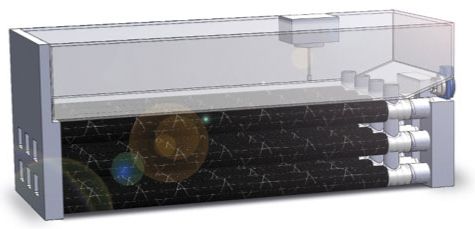
ReVolt[41], with headquarters in Portland, is developing Zinc-Air batteries[42]. Lithium-air[43] is said to be the dream battery. Electric vehicles are anticipated to have a range of 200 to 400 miles in the foreseeable future. Cost/effective batteries, with 2-3 times the present capacity, may largely resolve many range anxiety issues by allowing all day driving with overnight charging.
A Denmark battery company[44], Lithium Balance[45], has its eye on Portland as a potential U.S. headquarters. They build lithium batteries for industrial, military and consumer vehicles.

Lithium Balance hopes to make large Lithion Ion cells. Today, most battery packs are made from small cells, about the size of "D" batteries, in order to make them safer. The Prius Plug in and Hybrid uses NiMH batteries while the The Nissan Leaf uses a 24 kW/hr lithium-ion battery of their own design.
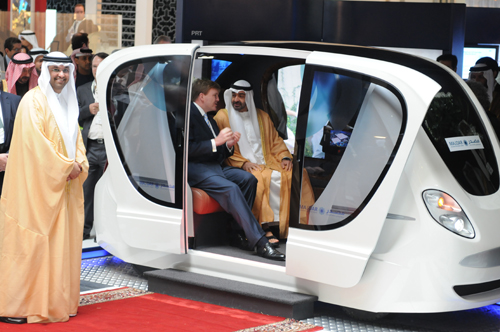
DriveOregon.org and the Oregon Electric Vehicle Association[46] gathers true believers while the WestCoastGreenHighway[47] has the latest on charging stations.
<< Back to: Green industry <<
- ↑ The U.S. has lurched from different transportation energy policies
- ↑ Oregon is coordinating many activities to facilitate successful, widespread deployment of plug-in vehicles
- ↑ Oregon's strategy for greenhouse gas reduction report
- ↑ There are 40 companies building either electric vehicles or component parts
- ↑ Drive Oregon
- ↑ Oregon-made electric vehicles
- ↑ Arcimoto
- ↑ Brammo
- ↑ Ryno Motors
- ↑ Green Lite Motors
- ↑ MotoCzysz
- ↑ Shorepower
- ↑ http://www.opconnect.com/welcome.aspx Optimization Technologies]
- ↑ grid energy storage
- ↑ Nissan Leaf
- ↑ all electric car
- ↑ Chevrolet Volt
- ↑ Ford's Focus Electric
- ↑ Plug-in hybrids
- ↑ Chevrolet's Volt
- ↑ Toyota Prius
- ↑ The plug-in hybrid Prius
- ↑ Nissan Leaf
- ↑ Lithium Ion batteries
- ↑ The Navistar eStar
- ↑ [http://www.oregon.gov/ODOT/HWY/OIPP/inn_ev-charging.shtml/ Oregon's Electric Vehicle Charging Network
- ↑ ECOtality's Fast chargers
- ↑ Washington State's Electric Highway project
- ↑ EV4Oregon.com
- ↑ offers Level 1 (30 minute charging) without the expense of a 440 volt line drop
- ↑ Coulomb Technologies
- ↑ ChargePoint Networked Charging Stations
- ↑ Thirteen Level II charging stations are now installed in downtown Hillsboro
- ↑ Shorepower Technologies
- ↑ Electrified Parking Spaces
- ↑ NEC's Takasago Rapid Charging Station
- ↑ CHAdeMO
- ↑ 50kW and 20kW capacities
- ↑ A 20 minute quick charger
- ↑ a 45-kilowatt photovoltaic carport
- ↑ ReVolt
- ↑ developing Zinc-Air batteries
- ↑ Lithium-air
- ↑ A Denmark battery company
- ↑ Lithium Balance
- ↑ Oregon Electric Vehicle Association
- ↑ WestCoastGreenHighway